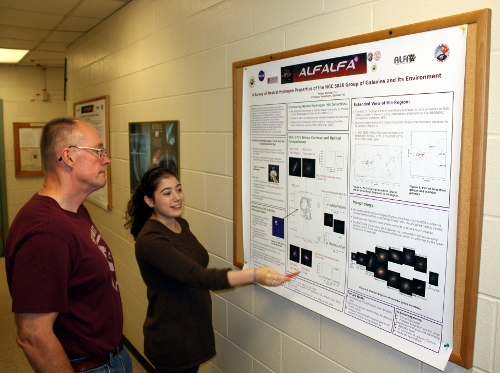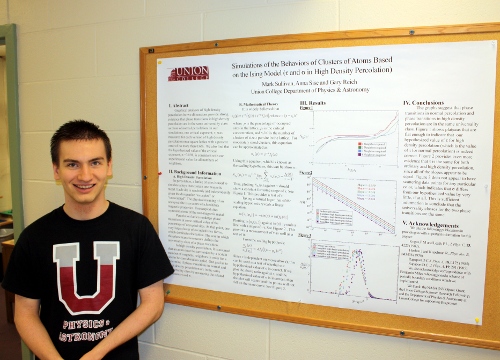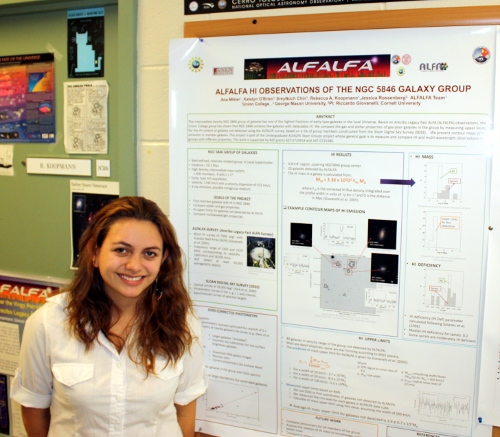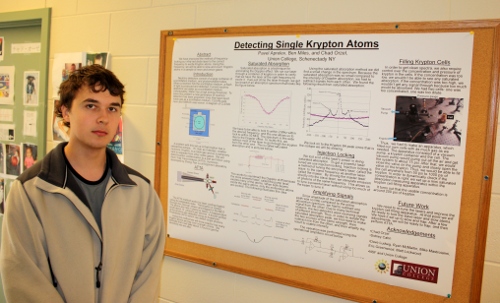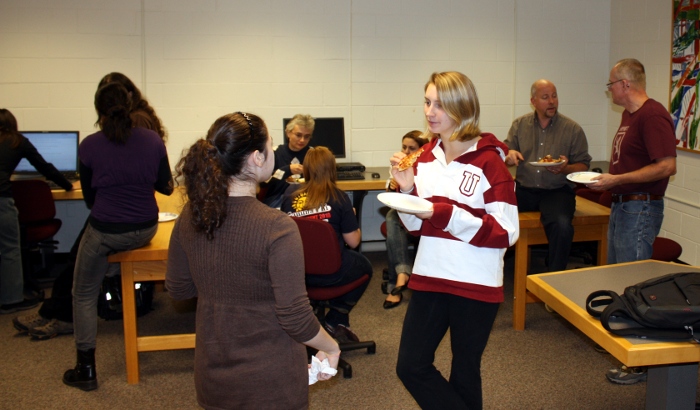Halley Darling ’13, shown explaining her summer research poster to Prof. Mike Vineyard, worked with Professor Koopmann using the Arecibo telescope to study hydrogen gas in a nearby group of galaxies. Their observations will help astronomers understand the evolution of galaxies and star formation within galaxies.
Summer Researcher: Mark Sullivan ‘13
Mark Sullivan ’13 worked with Anna Sise ’12 (who is on term abroad this Fall) and Prof. Reich doing computer simulations of atoms in lattices. The systems they studied are related to the physics of phase transitions in magnetic materials.
Colloquium 10/14/10: “Neutrino Physics and The Dayabay Experiment”
Speaker: Prof. John Cummings, Siena College
Title: Neutrino Physics and The Dayabay Experiment
Abstract: There has been a resurgence in interest in neutrino physics in the last 10 years. The observations of the Super-Kamiokande Experiment in 1998 indicated the “oscillation” of one flavor neutrino into another. Several experiments, now running or soon to begin, are attempting to map out the details of the neutrino mixing responsible for this oscillation phenomena. I will present a (brief) history of our understanding of the neutrino, and describe the phenomena of neutrino oscillations and what we can learn from them. Finally, I’ll describe the Dayabay experiment and it’s goals.
As always, the colloquium will be at 12:40 in Room N304, with pizza and soda available at 12:20 for those attending the talk. For details of future colloquia, see the Fall 2010 colloquium schedule.
Colloquium 10/8/10: “The Physics of Baseball”
Speaker: Prof. Charles Freeman, SUNY Geneseo
Title: The Physics of Baseball
Abstract: Baseball is a particularly interesting game for a physicist to study. What makes a curve ball curve? How much farther does the ball really travel at Coors Field in Denver than at Citi Field in New York? Why do left handed pitchers have more success against left handed batters (and right handed pitchers have more success against right handed batters)? What is the difference between a two-seam and a four-seam fastball? How do you throw a split-fingered fastball, anyway? An ex-pitcher and current physicist sheds some light on these questions and discusses some other interesting physics at work in our national pastime. Feel free to bring your glove — you just might catch a souvenir.
As always, the colloquium will be at 12:40 in Room N304, with pizza and soda available at 12:20 for those attending the talk. For details of future colloquia, see the Fall 2010 colloquium schedule.
Colloquium 9/30/10: “Astrophysical Alchemy: Creating the Heaviest Elements Within the Galaxy’s Biggest Explosions”
Speaker: Prof. Rebecca Surman
Title: Astrophysical Alchemy: Creating the Heaviest Elements Within the Galaxy’s Biggest Explosions
Abstract: While the origins of the light (hydrogen, helium) and intermediate mass (carbon through iron) elements found in our solar system are well understood, we still don’t know where roughly half of the elements heavier than iron were made. From the solar system abundance pattern of these nuclei, we can tell they were synthesized in conditions of high temperature and free neutron density. However, where these extreme conditions are found astrophysically is still uncertain. Here we will discuss aspects of heavy element synthesis in two potential astrophysical sites: the neutrino-driven wind of core-collapse supernovae and hot outflows from compact object mergers.
As always, the colloquium will be at 12:40 in Room N304, with pizza and soda available at 12:20 for those attending the talk. For details of future colloquia, see the Fall 2010 colloquium schedule.
Colloquium, 9/23/10: “Carbonaceous Contamination on Extreme Ultraviolet Lithography Mirrors Due to Different Wavelengths of Light “
Speaker: Petros Thomas
Title: Carbonaceous Contamination on Extreme Ultraviolet Lithography Mirrors Due to Different Wavelengths of Light
Abstract: Extreme Ultraviolet Lithography (EUVL) is one the leading candidates as the next generation of lithographic technology for the semiconductor industry. One of the challenges of EUVL is the carbonaceous contamination of the multilayer EUV mirrors in the tool which reduces the reflectivity of the mirrors in the desired wavelength range. Carbonaceous contamination on optical surfaces due to light in hydrocarbon environment is a major problem in different applications such as synchrotron beam lines, astronomy telescopes, and recently in EUV lithography. Although the problem has been around for a long time, the basic mechanism of the contamination is still not fully understood. The contamination is localized to the region of the surface exposed to light in the presence of hydrocarbons. The hydrocarbons dissociate and leave carbonaceous film in the exposed region of the surface. Whether the dissociation of the hydrocarbons is caused by the incoming photons of the light or secondary electrons from the surface is not well known.
Using a Xe-plasma source which emits not only the desired wavelength near 13.5 nm (EUV light) but a wide range of out-of-band (OOB) wavelengths extending as far as the visible region, we studied the carbonaceous contamination rates of different wavelength regions. We have measured the wavelength dependence of carbon contamination on a Ru-capped mirror. These results are compared to contamination rates on TiO2 and ZrO2 capping layers.
Colloquium, 9/23/10: “Carbonaceous Contamination on Extreme Ultraviolet Lithography Mirrors Due to Different Wavelengths of Light “
Speaker: Petros Thomas
Title: Carbonaceous Contamination on Extreme Ultraviolet Lithography Mirrors Due to Different Wavelengths of Light
Abstract: Extreme Ultraviolet Lithography (EUVL) is one the leading candidates as the next generation of lithographic technology for the semiconductor industry. One of the challenges of EUVL is the carbonaceous contamination of the multilayer EUV mirrors in the tool which reduces the reflectivity of the mirrors in the desired wavelength range. Carbonaceous contamination on optical surfaces due to light in hydrocarbon environment is a major problem in different applications such as synchrotron beam lines, astronomy telescopes, and recently in EUV lithography. Although the problem has been around for a long time, the basic mechanism of the contamination is still not fully understood. The contamination is localized to the region of the surface exposed to light in the presence of hydrocarbons. The hydrocarbons dissociate and leave carbonaceous film in the exposed region of the surface. Whether the dissociation of the hydrocarbons is caused by the incoming photons of the light or secondary electrons from the surface is not well known.
Using a Xe-plasma source which emits not only the desired wavelength near 13.5 nm (EUV light) but a wide range of out-of-band (OOB) wavelengths extending as far as the visible region, we studied the carbonaceous contamination rates of different wavelength regions. We have measured the wavelength dependence of carbon contamination on a Ru-capped mirror. These results are compared to contamination rates on TiO2 and ZrO2 capping layers.
Summer Researcher: Ana Mikler ‘12
Ana Mikler ’12 worked with Professor Koopmann using the Arecibo radio telescope to measure the amount of radio emission from hydrogen gas in nearby galaxies.
Summer Researcher: Pavel Aprelev ‘13
Pavel Aprelev ’13 spent four weeks working in Professor Orzel’s lab for the laser cooling and trapping of krypton. Pavel worked on improving the laser frequency stabilization system that allows the lasers to be tuned to exactly the right frequency for trapping metastable krypton atoms.
Summer Research Student Poster Session 2010
Students and faculty gathered in the department on Thursday, September 16th for the fourth annual Summer Research Student Poster Session, with 18 students presenting 16 posters on their research activities over the summer.
Watch this space for more details about the students and their projects.
